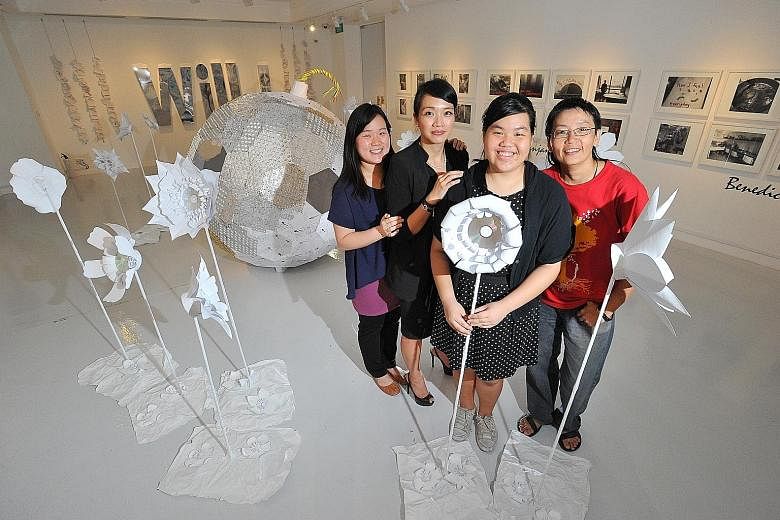On entering a white room in the Singapore Art Museum (SAM), one is instantly drawn to the huge structure at its heart, shaped unmistakably like a bomb.
On closer inspection, its glittering surface is a collage of used medicine foils and hospital bills.
The piece, The Life Within Transcends The Ticking Time Bomb, is one of five installations by four-year-old programme Project Dreamcatchers.
Supported by the National Youth Council, the National University Hospital (NUH) programme matches professional artists with young people living with chronic illnesses, who team up to produce art for an annual exhibition that aims to raise awareness of what being chronically ill is like.
This year's showcase, Take Me Places, opened on July 31 at SAM, the project's most prestigious exhibition venue to date, and will run until Sunday.
On display are the works of five artists and 19 patients. The latter are between 14 and 34 years old, and their chronic illnesses range from congenital heart disease to kidney failure and paraplegia, in which the patient's legs are paralysed.
For the four young patients who worked with eco-artist Rene Ong on Time Bomb, art is a way to convey to others the strain of daily life with their conditions, which are like "ticking time bombs".
Ms Ong, who is in her 40s, said: "When I realised what (the patients) need to go through every single day, how unstable their conditions might be, I wanted to show the balance they need to achieve."
For instance, she said, one of her team members, a 19-year-old with a rare genetic condition, needs to take medicine every day just to stay awake and attentive.
Said Ms Ong: "What happens if you take away the medicine? Will the bomb explode?"
The group covered the 1.6m-diameter sphere with emptied medicine foils and hospital bills they collected from patients in the programme, to emphasise the sheer amount of medication and expenses those with chronic illnesses must cope with.
However, inside the "bomb", they placed a cactus as a symbol of resilience at the heart of their challenges.
For Summer Tham, who has diabetes and a hole in her heart, the "bomb" became a way to tell her life story. The 16-year-old student said: "A lot of people tend to see us as freaks, because persons with diabetes need to inject themselves all the time, and they have to eat medication in front of their friends."
She said the chance to work on the exhibition has boosted her confidence and inspired her to pursue papier mache art further.
She also found a support group in her fellow patients. She said: "Other groups would treat me as a back-up plan. In this group, there are people taking care of me, and I am taking care of them."
The teams spent about 12 weeks working on their installations, meeting for three-hour sessions weekly.
The project's coordinators, NUH senior medical social worker Tang Kar Wai and senior art therapist Loo Hwee Hwee, said they wanted their patients to empower themselves through art.
Said Ms Tang, 27: "For their friends and families, and the medical staff who care for them, this is a side of them they may not have seen before. In the hospital, you only focus on the patient's condition."
Ms Loo, 39, said one patient with end-stage kidney failure, who adopted photography as his medium, told her that he initially expected his art to portray his pain and suffering. "But in the process of taking photos, he realised he had a lot of blessings. It is a very cathartic process," she added.
For aspiring artist and writer Vanessa Leong, the chance to exhibit at the museum is a dream come true. Because she has spina bifida, a birth defect where the spinal cord is not completely developed, she uses a wheelchair.
The 24-year-old used tracing paper to create a silhouette of herself inside a box, accompanied by a soundtrack that alternates between the music-box tinkle of Over The Rainbow and the grating sound of her wheelchair in motion.
She said: "Like the track, there are smooth seasons and rough seasons in my life. In the rough seasons, I sometimes want to give up, but there are lots of things I have to look forward to. This exhibition has really been one of them."
- The exhibition is on at the Singapore Art Museum, Gallery 2.7, until Sunday, from 10am to 7pm daily. Admission is free for Singaporeans, but the museum's charges apply to foreign visitors.


